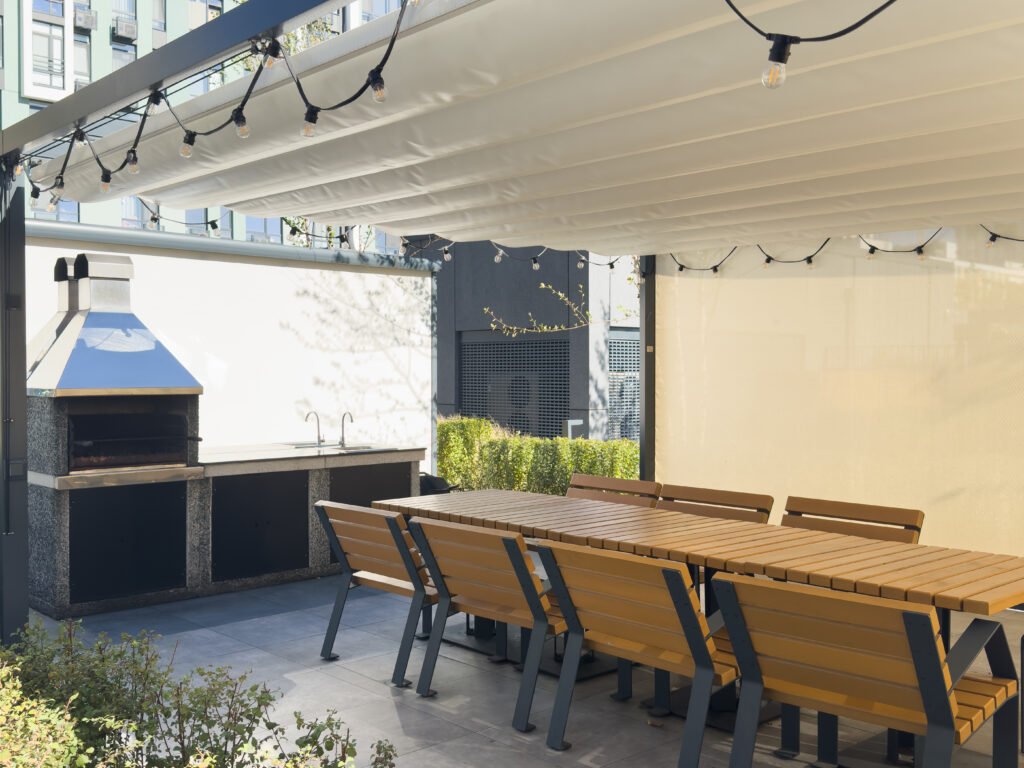G’day! If you’re scratching your head over which awning fabric to choose for your outdoor space, you’re not alone. As someone who’s spent years helping Aussie homeowners make this exact decision, I can tell you it’s not as straightforward as it might seem. But don’t worry – I’ll walk you through everything you need to know about waterproof and water-resistant awning fabrics.
Understanding Awning Fabric Basics
Before we dive into the nitty-gritty, let’s get our heads around what we’re dealing with. Think of awning fabrics as your home’s raincoat – just like you’d choose different jackets for different weather conditions, your choice of awning fabric depends on various factors.
“The right awning fabric can make the difference between creating an outdoor oasis and dealing with a maintenance nightmare,” says James Thompson, a leading Australian awning specialist with over 20 years of experience.
Types of Awning Materials
- Acrylic-coated
- PVC-coated
- Solution-dyed acrylic
- Polyester
- Canvas
Basic Properties to Consider
- UV resistance
- Water repellency
- Durability
- Breathability
- Maintenance requirements
Waterproof Awning Fabrics: The Complete Guide
Let’s cut to the chase – when we talk about waterproof awning fabrics, we’re talking about materials that are completely impervious to water. Picture a tin roof – that’s the level of water protection we’re dealing with here.
Key Features of Waterproof Fabrics
- Complete water blocking capability
- Higher density weave
- Special coating treatments
- Enhanced durability in heavy rain
“Waterproof fabrics are essentially creating a solid barrier between you and the elements,” explains Sarah Chen, textile engineer at the Australian Fabric Testing Institute. “They’re designed to handle everything from a light drizzle to a proper Melbourne downpour.”
Popular Waterproof Options
PVC-Coated Fabrics
- 100% waterproof
- Excellent durability
- Easy to clean
- Perfect for commercial applications
Laminated Fabrics
- Multiple protective layers
- Superior water resistance
- Greater thickness
- Ideal for permanent structures
Water-Resistant Fabrics: A Practical Alternative
Water-resistant fabrics are like your everyday jumper with water-repellent coating – they’ll keep you dry in a light shower but might not stand up to a tropical Queensland storm.
Advantages of Water-Resistant Fabrics
- Better breathability
- More colour options
- Lighter weight
- Often more affordable
- Natural look and feel
Common Water-Resistant Materials
Solution-Dyed Acrylic
- Industry standard
- Excellent colour retention
- Good water resistance
- Superior breathability
Treated Canvas
- Classic appearance
- Good durability
- Moderate water resistance
- Natural feel
Key Differences: Waterproof vs. Water-Resistant
Let me break this down with a real-world example. Think of waterproof fabrics as a wetsuit and water-resistant fabrics as board shorts. Both will protect you from water, but they serve different purposes and perform differently under various conditions.
Performance Comparison Table
| Feature | Waterproof | Water-Resistant |
|---|---|---|
| Rain Protection | Complete barrier | Repels most water |
| Breathability | Limited | Excellent |
| Durability | Very high | High |
| Weight | Heavier | Lighter |
| Cost | Higher | Moderate |
| Maintenance | Less frequent | Regular |
Making the Right Choice for Your Climate
Here’s where things get interesting – and where my experience with Australian conditions really comes in handy.
For Tropical North Queensland
- Choose fully waterproof fabrics
- Look for UV-stable materials
- Consider mould-resistant options
For Mediterranean Melbourne
- Water-resistant fabrics often suffice
- Focus on temperature regulation
- Consider seasonal usage
For Coastal Sydney
- Salt-resistant properties are crucial
- Balance between water resistance and breathability
- Consider wind resistance
Installation and Maintenance Tips
Getting the most out of your awning fabric isn’t just about choosing the right material – it’s about proper installation and maintenance.
Professional Installation Checklist
- Correct tension
- Proper slope for drainage
- Secure mounting points
- Weather-appropriate hardware
Maintenance Schedule
- Monthly visual inspections
- Quarterly cleaning
- Annual deep cleaning
- Seasonal adjustments
Cost Considerations and ROI
“The cheapest option rarely ends up being the most cost-effective,” notes Peter Williams, veteran awning installer from Brisbane. “It’s about finding the sweet spot between durability, performance, and price.”
Investment Breakdown
- Initial purchase cost
- Installation fees
- Maintenance requirements
- Expected lifespan
- Energy savings potential
Conclusion
Choosing between waterproof and water-resistant awning fabrics doesn’t have to be a headache. The key is understanding your specific needs, local climate, and usage patterns. Remember, there’s no one-size-fits-all solution – what works brilliantly for a beachside café in Bondi might not be ideal for a family home in Fremantle.
Quick Decision Tips
- Assess your local weather patterns
- Consider your primary use case
- Factor in maintenance commitment
- Think about long-term value
- Don’t forget about aesthetics
Frequently Asked Questions
How long do waterproof awning fabrics typically last?
With proper maintenance, waterproof awning fabrics can last 8-12 years, depending on climate conditions and usage.
Can water-resistant fabrics be made waterproof?
While water-resistant fabrics can be treated with additional waterproofing solutions, they’ll never match the performance of purpose-built waterproof fabrics.
What’s the best fabric for coastal areas?
Solution-dyed acrylic with marine-grade properties is typically the best choice for coastal areas due to its salt resistance and UV stability.
How often should I clean my awning?
Light cleaning every 3 months is recommended, with a deep clean annually. Increase frequency in areas with high pollution or bird activity.
Will waterproof fabrics make my outdoor area too hot?
Modern waterproof fabrics often include heat-reflective properties, but they generally provide less ventilation than water-resistant options.
Are waterproof awnings more expensive to maintain?
While initial costs are higher, waterproof awnings typically require less frequent maintenance, potentially reducing long-term costs.
Can I install an awning myself?
While DIY installation is possible, professional installation is recommended to ensure proper tension, angle, and weatherproofing.


